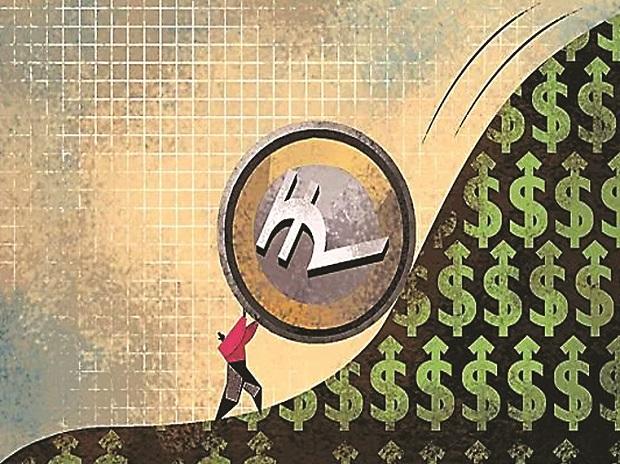[ad_1]
The rupee plummeted against the dollar on Tuesday, shedding 1 per cent (82 paise), as stronger-than-expected economic data released in the US on Monday rekindled fears of aggressive Fed rate hikes.
Also, relentless dollar purchases by corporates and oil companies dragged the local currency lower. The rupee settled at 82.62 per dollar against 81.80 on Monday.
So far in 2022, the domestic currency has depreciated 10.0 per cent versus the dollar.
Tuesday’s move in the rupee marks the sharpest single-day slide since October 22, traders said.
The US dollar index was at 105.26 at 3:30 pm IST versus 104.47 the same time on Monday.
Currency traders also cited a recent drop in dollar/rupee forward premiums as a reason behind weakness in the rupee.
This, over the past couple of days, suffered to a far greater extent than its peer currencies. Over the past two days, the rupee has weakened 1.6 per cent.
The forward premium represents the rate differential between Indian and US assets.
That gap has been shrinking due to a faster pace of interest rate hikes by the Federal Reserve compared to the Reserve Bank of India (RBI).
A narrowing interest rate differential between India and the US reduces the appeal of domestic assets.
A decline in the forward premium is beneficial for importers as it reduces their cost of hedging currency risk.
For exporters, however, the development is an adverse one. This is because it reduces the returns they receive while selling dollars, traders said.
“Corporate flows and oil bids continued to push the dollar/rupee pair higher. But it is also important to note that the lower forward premium makes carry trade unfavourable. Exporters thus remain less enticed to hedge. Thus, it reduces the supply of dollars in the forward market, which in turn also suggests dollar cash crunch,” Kunal Sodhani, vice-president, Shinhan Bank (Global Trading Centre) said.
The one-year annualised dollar/rupee forward premium rate was at 1.64 per cent on Tuesday, dealers said. It was hovering around an 11-year low. The rate was at 2.4 per cent on October 31.
Apart from the sharp weakness over the past two days, the rupee has, over the last month, also underperformed most of its emerging market peer currencies. These currencies have notched up sharp gains amid a hefty decline in the US dollar index.
Bloomberg data showed that from October 31 to December 2, the rupee gained a mere 1.8 per cent against the dollar, underperforming nine other emerging market currencies. The US dollar index declined over 6 per cent during that period.
Analysts said that the rupee’s relative underperformance was in line with fundamental factors such as a widening trade deficit.
“There has been a degree of underperformance, which is reversing the out-performance that the currency had through the last four-five months. This could be related to the underlying demand itself because the current account numbers are not adjusting quickly. Our exports have come off much faster than our imports,” Rahul Bajoria, Barclays’ head of EM-Asia (ex-China) economics research said.
“At the same time, capital flows, while they are coming in, are not overwhelming. And the rupee has not weakened that much — we have not seen incrementally a lot of money being allocated to India,” he said.
The rupee’s 10 per cent depreciation so far in 2022, is of a lower order than that suffered by several other currencies, including those in advanced economies.
The combination of risk aversion and economic disruption caused by the Ukraine war and the Fed’s aggressive monetary tightening have led to sweeping dollar strength in 2022.
Moreover, the RBI, which has heavily drawn down on foreign exchange reserves in 2022 to protect the rupee, is seen replenishing its holdings of dollars. This is limiting the gains for the Indian currency.
“There is strong expectation that RBI will use episodes of the stronger rupee to rebuild FX reserves, given that India is an emerging economy. We forecast both December and March rupee levels at 83,” said Standard Chartered Bank’s head of economic research, South Asia, Anubhuti Sahay.
[ad_2]
Source link



